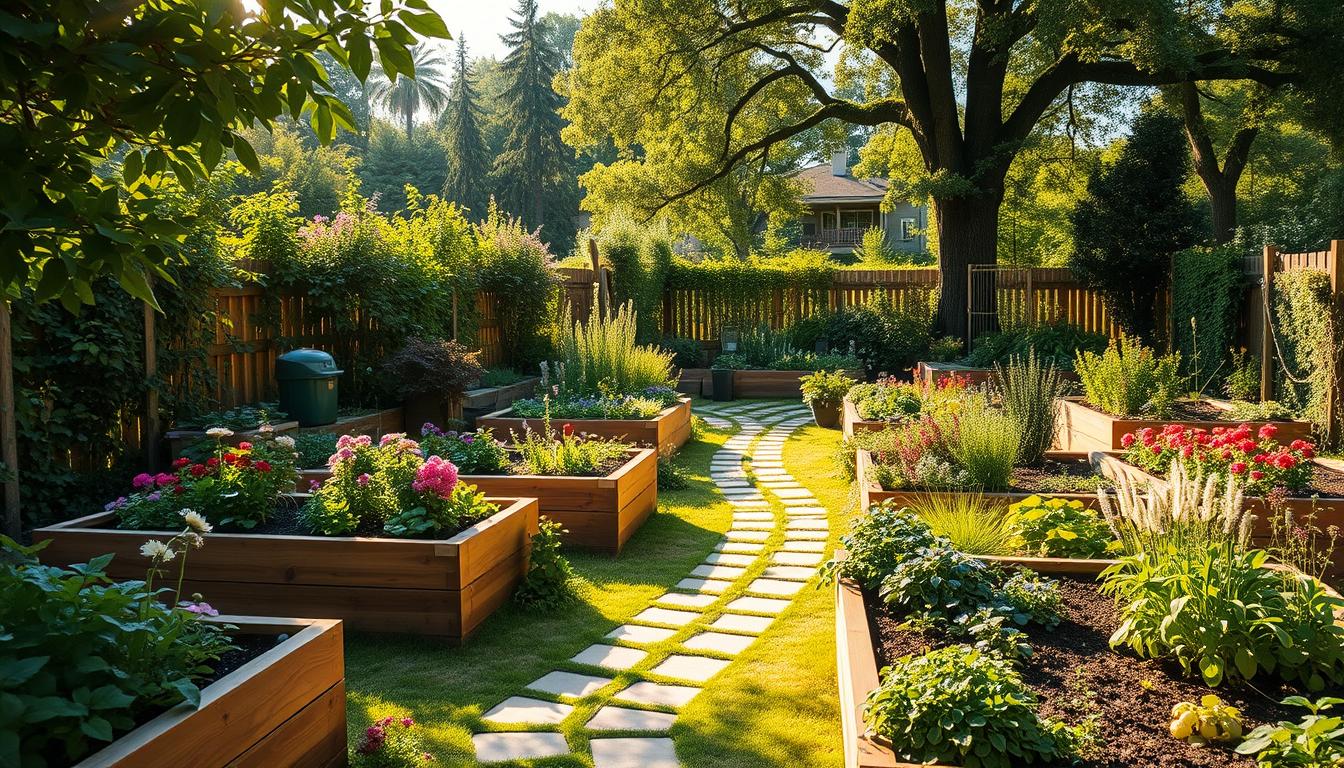Transforming your yard into a stunning outdoor space doesn’t have to be complicated. With raised bed landscaping, you can create a functional and visually appealing area that suits your needs. Whether you’re a beginner or an experienced gardener, this method offers endless possibilities.
This guide will walk you through nine key strategies to elevate your yard. From choosing the right materials to advanced techniques, you’ll learn how to make the most of your space. Raised beds are not only customizable but also improve drainage and help with pest control, making them a practical choice for any garden.
No matter the size of your yard, this approach is accessible and rewarding. Dive in to discover how you can create a beautiful landscape that reflects your style and enhances your outdoor living experience.
Key Takeaways
- Raised bed landscaping enhances both aesthetics and functionality.
- It’s customizable for yards of all sizes.
- Improved drainage and pest control are key benefits.
- This method is beginner-friendly yet versatile for experts.
- Nine strategies will help you create a stunning outdoor space.
Introduction to Raised Bed Landscaping
Discover a gardening method that combines beauty and practicality. Elevated planting areas are a modern solution for creating stunning outdoor spaces. Unlike traditional in-ground gardens, these structures use frames made of wood, stone, or recycled materials to hold soil above the ground.
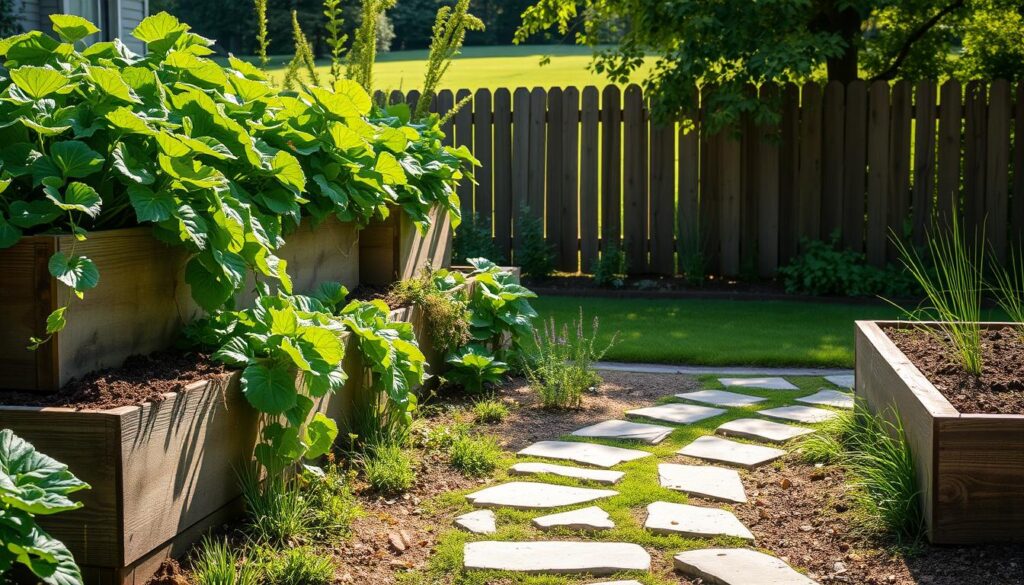
One of the biggest advantages is faster soil warming. Studies show that elevated areas warm up 32% quicker than traditional gardens. This means your plants get a head start in the growing season. Additionally, these setups reduce weed intrusion by up to 60%, making maintenance easier.
What is Raised Bed Landscaping?
This technique involves creating planting areas that are higher than the surrounding ground. The frames can be made from various materials, each offering unique benefits. For example, metal frames warm the soil 15% faster than wood, giving your plants an extra boost.
Why Choose Raised Beds for Your Yard?
There are several reasons to consider this approach. First, it’s highly customizable, allowing you to design a space that fits your needs. Second, it’s accessible for those with mobility challenges, as the elevated height reduces the need to bend or kneel.
Costs for initial setup range from $150 to $500, but long-term maintenance is often on par with traditional gardens. A real-world example from Gardenary highlights a Mother’s Day project that transformed a small yard into a thriving garden bed. This method is not only practical but also adds a unique aesthetic to your outdoor space.
For beginners, gardening for beginners can be a great starting point to learn more about creating your own elevated planting areas. Whether you’re looking to improve soil quality or reduce weeds, this approach offers a versatile solution for any yard.
The Benefits of Raised Bed Landscaping
Elevating your garden’s potential starts with understanding the advantages of this method. From healthier plants to easier maintenance, this approach offers numerous benefits that make gardening more enjoyable and productive.

Improved Soil Drainage
One of the standout benefits is enhanced drainage. Studies show that these setups provide 40% better drainage compared to traditional in-ground gardens. Layered gravel or straw at the bottom prevents waterlogging, ensuring your plants thrive even during heavy rains.
Better Pest and Weed Control
Keeping pests and weeds at bay is easier with this method. Wire mesh solutions can prevent gophers and other critters from damaging your garden. Clients report 2.8x fewer pest issues when using these structures. Additionally, the elevated design naturally reduces weed growth, saving you time and effort.
Customizable Soil Composition
Another advantage is the ability to tailor the soil to your needs. Whether your plants prefer acidic or alkaline conditions, you can adjust the pH levels for optimal growth. Techniques like lasagna gardening also help save on soil costs while improving its quality.
For example, a 19-bed system maintained over 10 years showcased remarkable success. This method not only improves plant health but also maximizes your garden’s potential in any space.
Choosing the Right Materials for Your Raised Beds
Selecting the right materials is the foundation of a successful garden project. The type of wood, stone, or recycled items you use can impact durability, aesthetics, and even plant health. Let’s explore the best options to create a functional and beautiful landscape.
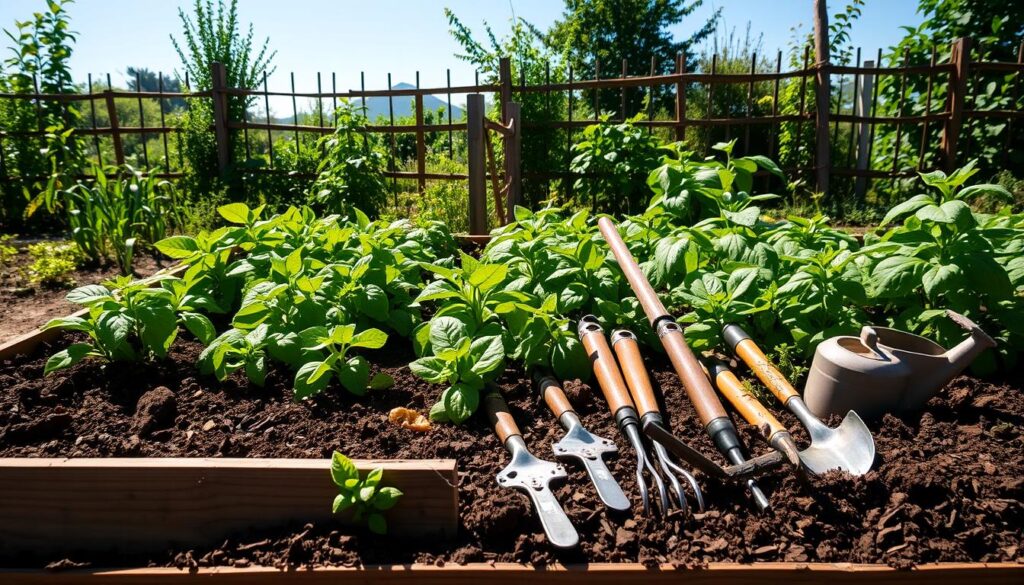
Wood: A Popular Choice
Wood is a favorite for many gardeners due to its natural look and versatility. Cedar is highly recommended for its rot resistance, with 85% of gardeners preferring it. However, avoid pressure-treated lumber, as it may contain harmful chemicals. Heat-treated (HT) pallets are a safer alternative.
Stone and Brick for Durability
For a long-lasting solution, consider stone or brick. Concrete blocks can raise soil pH by 0.5-1.0 points, making them ideal for certain plants. You can choose between dry-stack or mortared construction, depending on your preference and cost considerations.
Recycled Materials for Eco-Friendly Options
Upcycling items like milk crates or tires can reduce cost by up to 70%. These eco-friendly options are not only budget-friendly but also add a unique touch to your garden. However, be cautious with terracotta, as its porosity can lead to water loss, unlike PVC, which retains moisture.
Here are five unexpected materials you can use:
- Culvert pipes
- Old dressers
- Bathtubs
- Shipping pallets
- Wine barrels
By choosing the right materials, you can create a garden that’s both practical and visually appealing. Whether you prefer the natural charm of wood or the durability of stone, there’s an option for every gardener.
Designing Your Raised Bed Garden
Creating a functional and beautiful outdoor area starts with smart design. A well-thought-out layout ensures your space is both practical and visually appealing. Whether you’re working with a small yard or a sprawling area, planning is key to maximizing your garden’s potential.

Planning the Layout
Start by considering the size and shape of your area. For accessibility, keep the width under 4 feet. This allows you to reach the center without stepping on the soil. Use 3D planning tools to account for slopes and sun patterns. This ensures your plants get the right amount of light throughout the day.
Incorporating Multi-Level Beds
Multi-level designs add depth and interest to your space. Peter Donegan’s work showcases how integrated seating can blend seamlessly with planting areas. Stone spiral gardens not only look stunning but also provide thermal mass, keeping roots at an ideal 68°F in metal troughs.
Adding Seating and Functional Spaces
Make your garden a place to relax and enjoy. Include seating areas that double as functional spaces. For wheelchair accessibility, aim for a height of 30 inches. Vertical elements like trellises can maximize space, perfect for growing zucchini or other climbing plants.
With thoughtful design, your garden can become a versatile and inviting outdoor haven. Focus on accessibility, creativity, and functionality to create a space that works for you.
Essential Tips for Building Raised Beds
Building a garden structure that suits your needs starts with smart planning. Whether you’re a beginner or an experienced gardener, these tips will help you create a functional and long-lasting setup. From choosing the right height to ensuring proper drainage, every detail matters.
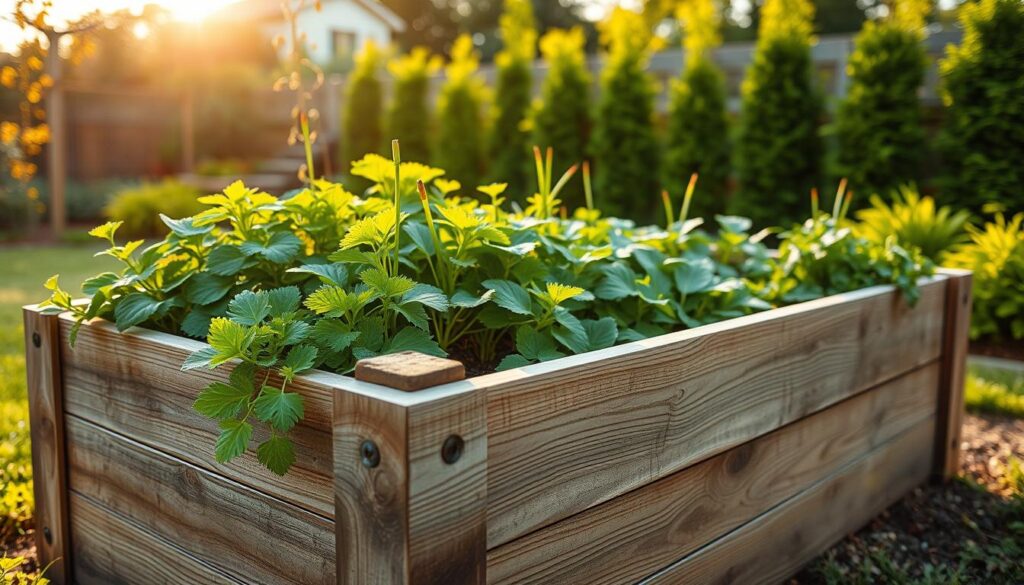
Determining the Right Height
The height of your garden structure plays a key role in its functionality. For accessibility, aim for a height of 15-30 inches. This reduces bending and makes gardening easier for everyone. Here’s a quick guide:
| Purpose | Recommended Height |
|---|---|
| Vegetables | 8 inches |
| Accessibility | 24 inches |
Ensuring Proper Drainage
Good drainage is essential for healthy plants. Adding a 1-inch layer of gravel at the base can improve drainage by 40%. This prevents waterlogging and ensures your plants thrive. Avoid using landscape fabric, as it can trap water and harm roots.
Using the Right Tools and Techniques
Choosing the right tools makes the process smoother. An auger is 2.5x more efficient than a spade for digging. When building with wood, use screws instead of nails to prevent warping over time. For a low-maintenance option, consider self-watering systems like Gardyn, which keep your plants hydrated with minimal effort.
By focusing on these essential tips, you can create a garden structure that’s both functional and beautiful. Start with smart planning, and your garden will thrive for years to come.
Planting in Raised Beds: What You Need to Know
Growing your favorite vegetables and herbs in elevated structures can be both rewarding and efficient. With proper planning, you can maximize your garden’s potential and enjoy a bountiful harvest. Here’s how to get started.
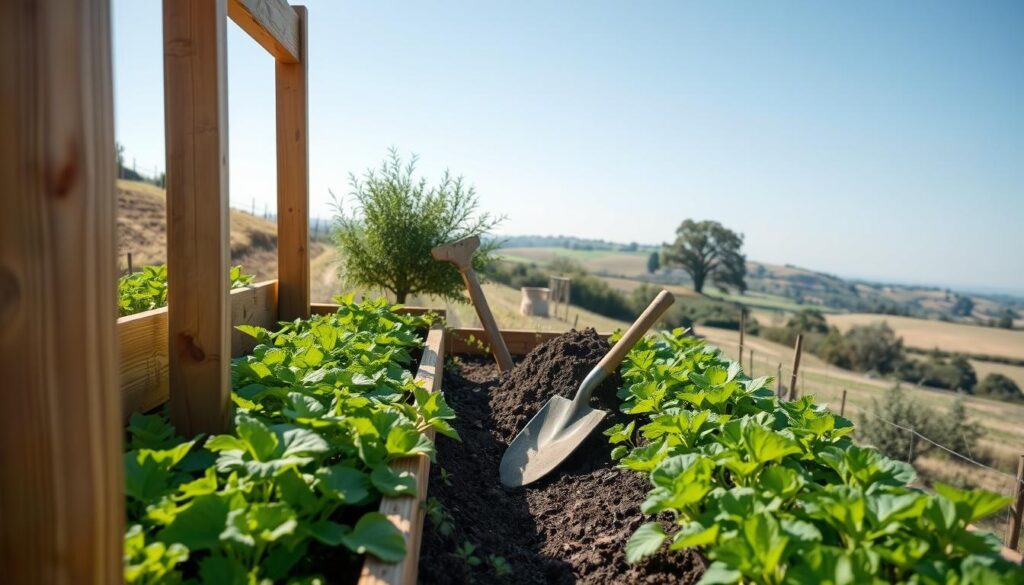
Choosing the Right Plants
Not all plants thrive in elevated structures. Carrots, for example, have a 90% success rate compared to 60% in traditional gardens. Tomatoes, kale, and radishes are also excellent choices. Avoid pairing asparagus with blackberries, as they can stunt each other’s growth.
Spacing and Arrangement
Proper spacing ensures healthy roots and prevents overcrowding. Square foot gardening can increase yields by 30%. Companion planting, like pairing basil with tomatoes, can also boost growth and deter pests.
Maintaining Healthy Soil
Healthy soil is the foundation of a thriving garden. Lasagna layering—alternating organic materials like leaves and compost—improves soil health. Seasonal crop rotation prevents nutrient depletion and keeps your plants strong.
Here are some tips to keep in mind:
- Rotate crops annually to maintain soil fertility.
- Add compost regularly to enrich the soil.
- Use mulch to retain moisture and suppress weeds.
By following these guidelines, you can create a productive and beautiful space for your favorite herbs and vegetables. Happy planting!
Creative Raised Bed Garden Ideas
Unlock the potential of your outdoor area with creative gardening ideas. Whether you’re working with a small plot or a sprawling yard, innovative designs can transform your space into a vibrant oasis. From spiral gardens to vertical setups, these concepts combine functionality with visual appeal.
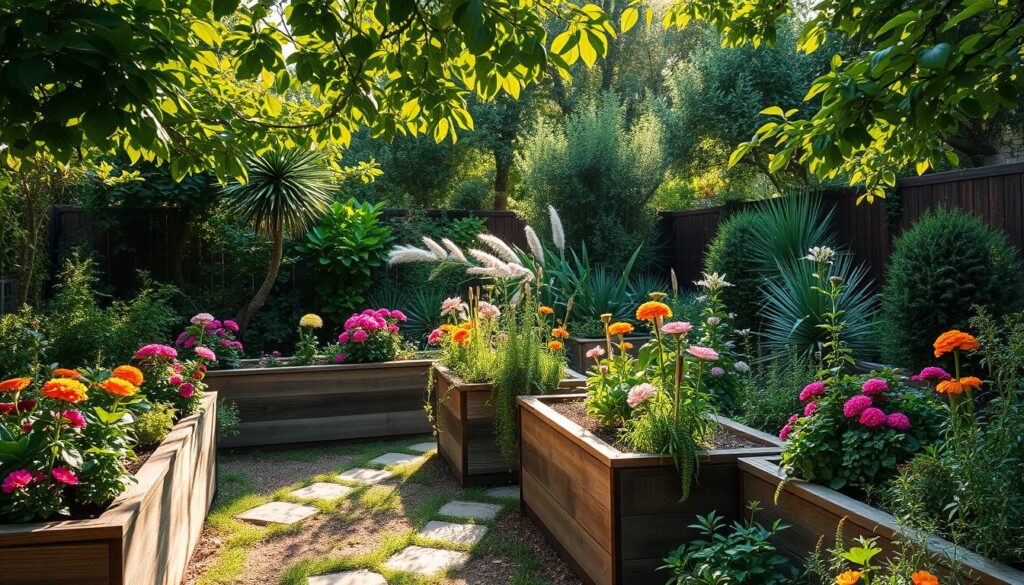
Spiral Gardens for Visual Appeal
Spiral gardens are a stunning way to maximize your planting area. Studies show they increase usable space by 22%, making them ideal for growing herbs, flowers, or vegetables. The spiral design not only looks beautiful but also creates microclimates, allowing you to grow a variety of plants in one compact area.
Consider incorporating edible flowers like nasturtiums or marigolds for a pop of color. These blooms are not only visually appealing but also attract pollinators, enhancing your garden’s ecosystem.
Vertical Gardening in Raised Beds
Vertical gardening is a smart solution for limited space. Cattle panel trellises are a popular choice, used in 85% of vertical setups. They’re sturdy, easy to install, and perfect for climbing plants like beans, cucumbers, or even small melons.
For a DIY project, try building a pallet wall garden. It’s an affordable and eco-friendly way to add greenery to your fence or wall. Simply attach planters to the pallet and fill them with your favorite herbs or flowers.
Using Containers and Troughs
Containers and troughs offer flexibility and mobility in your garden. Mobile milk crate systems are a great option for small spaces. They’re lightweight, easy to move, and can be arranged in various configurations to suit your needs.
Trough gardens with drip irrigation are another excellent choice. They’re ideal for growing herbs or vegetables and ensure your plants stay hydrated with minimal effort. For a unique touch, try hanging gutter planters along a wall or fence.
| Design Idea | Benefits |
|---|---|
| Spiral Gardens | Increase planting area by 22% |
| Vertical Gardening | Maximizes space with trellises |
| Containers and Troughs | Offers flexibility and mobility |
For more inspiration on creative gardening, visit NewGen Living. These ideas will help you design a garden that’s both functional and visually stunning.
Seasonal Care for Raised Bed Gardens
Keeping your garden thriving year-round requires attention to seasonal changes. Each season brings unique challenges and opportunities for your plants. By adapting your care routine, you can ensure a healthy and productive garden no matter the time of year.
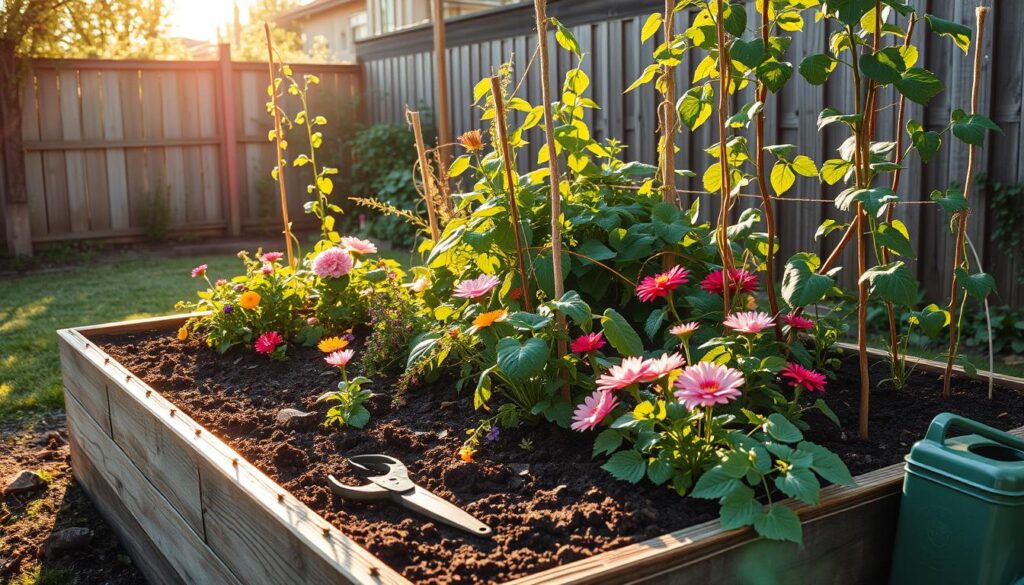
Spring Planting Tips
Spring is the perfect time to get your garden started. Begin by preparing the soil with a thorough cleaning and nutrient boost. Adding compost or organic matter can improve soil health and provide essential nutrients for your plants.
For a head start, consider planting seeds indoors two weeks before the last frost. This gives your plants a better chance to thrive once transplanted. Hoop houses can also extend your growing season by up to six weeks, allowing you to enjoy fresh produce earlier.
- Clean and aerate the soil.
- Add compost or organic matter.
- Start seeds indoors for a head start.
Summer Maintenance
Summer is all about keeping your garden hydrated and healthy. Establish a consistent watering schedule to ensure your plants get enough water without overwatering. Early morning is the best time to water, as it reduces evaporation and helps prevent disease.
Regularly check for pests and weeds, which can thrive in the warm weather. Mulching around your plants can help retain moisture and suppress weeds, keeping your garden in top shape.
- Water early in the morning.
- Monitor for pests and weeds.
- Use mulch to retain moisture.
Preparing for Winter
As the growing season winds down, it’s essential to prepare your garden for winter. Start by removing any dead or diseased plants to prevent pests from overwintering. Covering your garden with burlap or mulch can protect the soil and insulate plant roots from freezing temperatures.
Consider planting cover crops like clover or rye to enrich the soil during the off-season. These crops prevent erosion and add nutrients, ensuring your garden is ready for spring.
- Remove dead or diseased plants.
- Cover soil with burlap or mulch.
- Plant cover crops for soil health.
By following these seasonal care tips, you can maintain a vibrant and productive garden throughout the year. Adapt your routine to the changing level of care each season requires, and your garden will reward you with beauty and bounty.
Watering and Irrigation Strategies
Efficient watering methods can make all the difference in your garden’s success. Whether you’re using advanced systems or simple techniques, the right approach ensures your plants stay healthy and productive. Let’s explore the best ways to manage water in your garden.

Drip Irrigation Systems
Drip systems are a game-changer for gardeners. According to the EPA, they reduce water usage by 50%. These systems deliver water directly to the plant roots, minimizing waste and evaporation.
When choosing between a soaker hose and a drip line, consider the cost and efficiency. Soaker hoses are cheaper but less precise, while drip lines offer better control. Here’s a quick comparison:
| Type | Cost | Efficiency |
|---|---|---|
| Soaker Hose | $20-$30 | Moderate |
| Drip Line | $50-$100 | High |
Manual Watering Techniques
For those who prefer hands-on care, manual watering can be effective. DIY bottle irrigation is a simple and affordable way to keep your plants hydrated. Simply poke holes in a plastic bottle, bury it near the roots, and fill it with water.
Another option is wicking bed construction. This method uses a reservoir to draw water up into the soil, ensuring consistent moisture levels. It’s perfect for busy gardeners who want to save time.
Conserving Water in Raised Beds
Water conservation is crucial for sustainable gardening. Straw mulch retains 30% more moisture, reducing the need for frequent watering. Ollas, or clay pots buried in the soil, are another efficient option. They slowly release water, keeping plants hydrated for longer periods.
For different soil types, adjust your watering schedule. Clay soils hold water longer, while sandy soils drain quickly. By tailoring your approach, you can maximize efficiency and keep your garden thriving.
Dealing with Pests and Diseases
Protecting your garden from unwanted visitors and diseases is easier than you think. With the right strategies, you can keep your plants healthy and thriving. From natural remedies to physical barriers, there are plenty of ways to safeguard your garden.
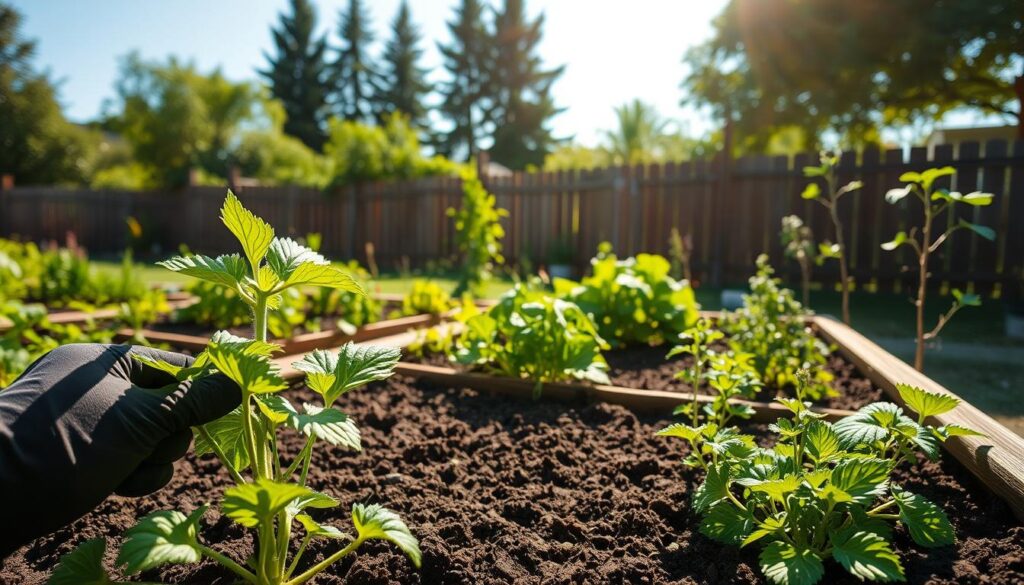
Natural Pest Control Methods
Using natural solutions is a safe and effective way to manage pests. Neem oil, for example, controls 90% of aphids and other common invaders. Companion planting is another great option. Pairing marigolds with tomatoes can deter harmful insects while adding color to your garden.
DIY sprays are also helpful. A simple garlic spray can repel many unwanted visitors. Mix crushed garlic with water, let it sit overnight, and spray it on your plants. This eco-friendly solution is both affordable and effective.
Preventing Common Diseases
Healthy plants are less likely to fall victim to diseases. Crop rotation is a proven method to prevent soil-borne illnesses. By changing the location of your crops each season, you reduce the risk of nutrient depletion and disease buildup.
Row covers are another excellent tool. They protect your plants from pests and harsh weather while allowing sunlight and water to pass through. Installing them is simple and can make a big difference in your garden’s health.
Using Barriers and Fences
Physical barriers are a reliable way to keep larger pests at bay. Chicken wire, for instance, reduces mammal damage by 80%. Installing a fence around your garden can prevent rabbits, deer, and other animals from feasting on your crops.
For smaller pests, consider creating a beneficial insect hotel. These structures attract helpful insects like ladybugs and bees, which naturally control harmful pests. It’s a win-win for your garden and the environment.
“A well-protected garden is a thriving garden. Simple solutions like barriers and natural sprays can make all the difference.”
By combining these methods, you can create a garden that’s both beautiful and resilient. Focus on prevention, and your plants will reward you with a bountiful harvest.
Cost Considerations for Raised Bed Landscaping
Planning your garden project doesn’t have to break the bank. Understanding the financial aspects of materials, setup, and maintenance can help you create a beautiful space without overspending. Whether you’re working with a tight budget or looking for long-term savings, these tips will guide you every step of the way.
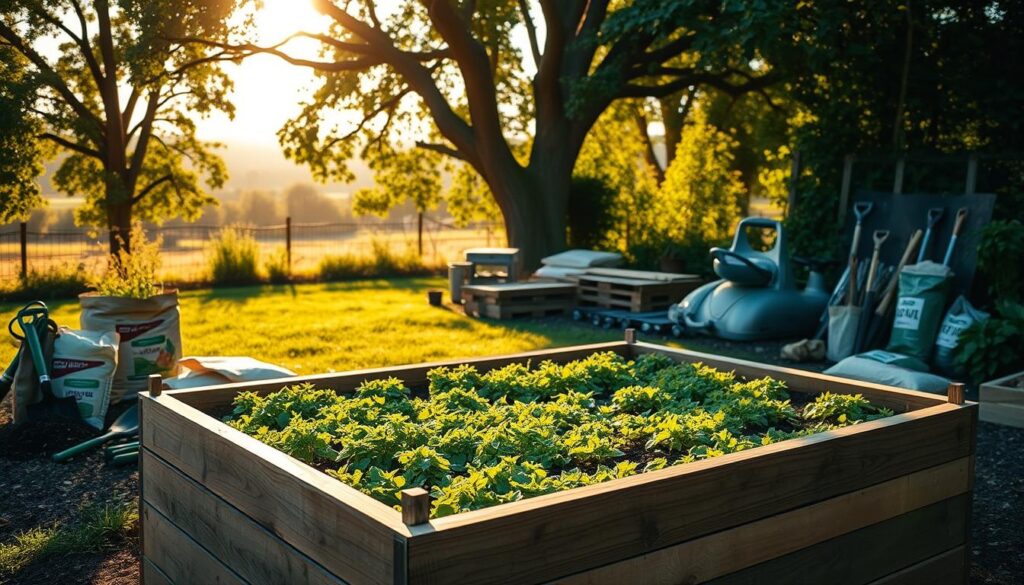
Initial Setup Costs
The average setup cost for a garden structure is around $25 per square foot. This includes materials like wood, stone, or recycled items. Using recycled pallets can save you up to 70%, making it a budget-friendly option. Here’s a quick comparison of materials:
- Wood: $15-$30 per linear foot
- Stone: $20-$50 per linear foot
- Recycled pallets: $5-$10 per unit
Long-Term Maintenance Expenses
Over time, maintenance costs for garden structures are often comparable to traditional gardens. However, using durable materials like cedar or stone can reduce repair expenses. A 5-year analysis shows that elevated setups save 20% on soil amendments and pest control compared to in-ground gardens.
Budget-Friendly Tips
Here are some practical ways to save money on your garden project:
- Source free soil amendments from local compost programs.
- Check community lumber mills for discounted materials.
- Rent tools instead of purchasing them to save upfront costs.
By making smart choices, you can create a stunning garden without exceeding your budget. Focus on quality materials and efficient planning to maximize your investment.
Raised Bed Landscaping for Small Spaces
Small spaces can still host vibrant gardens with the right approach. Whether you’re working with a tiny yard, balcony, or even a windowsill, there are ways to maximize your space and grow healthy plants. With smart design and creative solutions, you can turn even the most compact areas into lush green retreats.
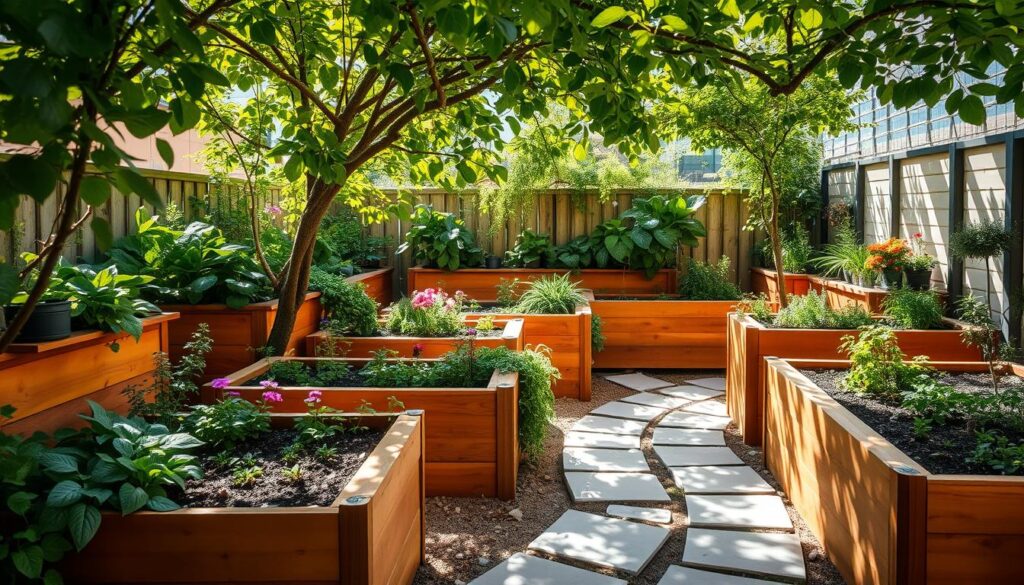
Maximizing Limited Areas
When working with limited space, every inch counts. A 4’x4′ bed can yield up to 16 plants, making it a great option for small areas. Use vertical structures like trellises or corner shelves to add more growing space without taking up extra feet on the ground.
For balconies, consider wheeled bed designs. These allow you to move your garden around to catch the best sunlight. Studies show that 93% of balcony gardeners use this method to optimize their space.
Compact Design Ideas
Compact designs are perfect for small home gardens. Vertical strawberry towers or windowsill herb boxes are excellent for growing fresh produce in tight areas. Foldable bed designs are ideal for renters, offering flexibility and easy storage.
Salad tables or corner trellises can also maximize your space. These designs are not only functional but also add a decorative touch to your garden.
Portable Raised Beds
Portable beds are a game-changer for small spaces. They’re easy to move, making them perfect for renters or those who like to rearrange their garden frequently. Lightweight materials like cedar or recycled plastic are great for these designs.
Here’s a quick comparison of portable options:
| Type | Benefits |
|---|---|
| Wheeled Beds | Easy to move, ideal for balconies |
| Foldable Beds | Space-saving, perfect for renters |
| Salad Tables | Compact, great for small patios |
With these tips, you can create a thriving garden even in the smallest of spaces. Focus on smart designs and portable solutions to make the most of your area.
Integrating Raised Beds into Your Overall Landscape
Designing a cohesive outdoor area can elevate your home’s aesthetic and functionality. By blending garden features seamlessly, you create a harmonious space that enhances both beauty and practicality. Whether you’re starting from scratch or updating an existing landscape, thoughtful planning ensures every element works together.
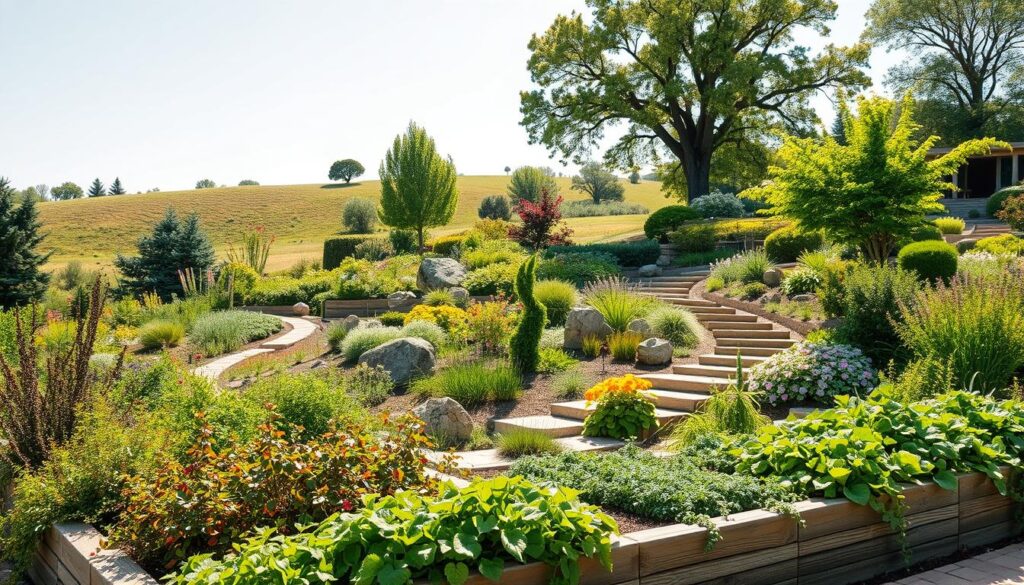
Blending with Existing Garden Features
One of the best ways to integrate garden elements is through transitional planting strategies. Use similar colors and textures to connect different areas of your yard. For example, matching flowering plants in your garden beds with those in your lawn creates a unified look.
Decorative edge treatments, like stone borders or wooden frames, also help blend garden features. These additions not only look great but also define spaces clearly. Studies show that color-coordinated designs can increase your home’s value by up to 3%.
Creating Focal Points
Focal points draw the eye and add interest to your landscape. Consider using unique plants, sculptures, or water features as centerpieces. Night lighting is another effective way to highlight these elements, creating a stunning visual effect after dark.
Pathway alignment is crucial for guiding attention. Straight paths lead directly to focal points, while curved paths create a sense of discovery. Both styles can enhance the overall flow of your outdoor space.
Enhancing Curb Appeal
Your front yard is the first thing visitors see, so make it count. Four-season interest planning ensures your garden looks great year-round. Combine evergreen shrubs with seasonal flowers for a dynamic display.
Here are some tips to boost curb appeal:
- Use native plants for low-maintenance beauty.
- Add mulch to keep the area tidy and retain moisture.
- Install lighting along pathways for safety and style.
“A well-designed landscape not only enhances your home’s appearance but also provides a functional and enjoyable outdoor space.”
By integrating these strategies, you can create a landscape that’s both beautiful and practical. Focus on blending features, creating focal points, and enhancing curb appeal to make the most of your outdoor area.
Common Mistakes to Avoid in Raised Bed Gardening
Avoiding common pitfalls can make your gardening journey smoother and more rewarding. Even small errors can lead to big problems, like reduced yields or unhealthy plants. By understanding these mistakes, you can create a thriving garden that’s both beautiful and productive.
Overcrowding Plants
One of the most common mistakes is planting too many plants in a small space. Overcrowding can reduce yields by up to 40% and increase the risk of disease. Proper spacing ensures each plant has enough room to grow and access to sunlight, water, and nutrients.
Here’s a quick guide for spacing common vegetables:
| Vegetable | Spacing (inches) |
|---|---|
| Tomatoes | 24-36 |
| Lettuce | 8-12 |
| Carrots | 2-4 |
Neglecting Soil Health
Healthy soil is the foundation of a successful garden. Neglecting it can lead to nutrient deficiencies and poor plant growth. Annual soil testing can prevent 90% of these issues by identifying what your garden needs.
Here are some tips to maintain soil health:
- Add compost or organic matter regularly.
- Rotate crops to prevent nutrient depletion.
- Use mulch to retain moisture and suppress weeds.
Ignoring Drainage Issues
Poor drainage can drown your plants and lead to root rot. Installing a French drain or adding gravel at the base of your bed can improve drainage by up to 40%. Signs of overwatering include yellowing leaves and soggy soil.
Here’s how to avoid drainage problems:
- Ensure your bed has a slight slope for water runoff.
- Avoid using landscape fabric, which can trap water.
- Check soil moisture regularly to prevent overwatering.
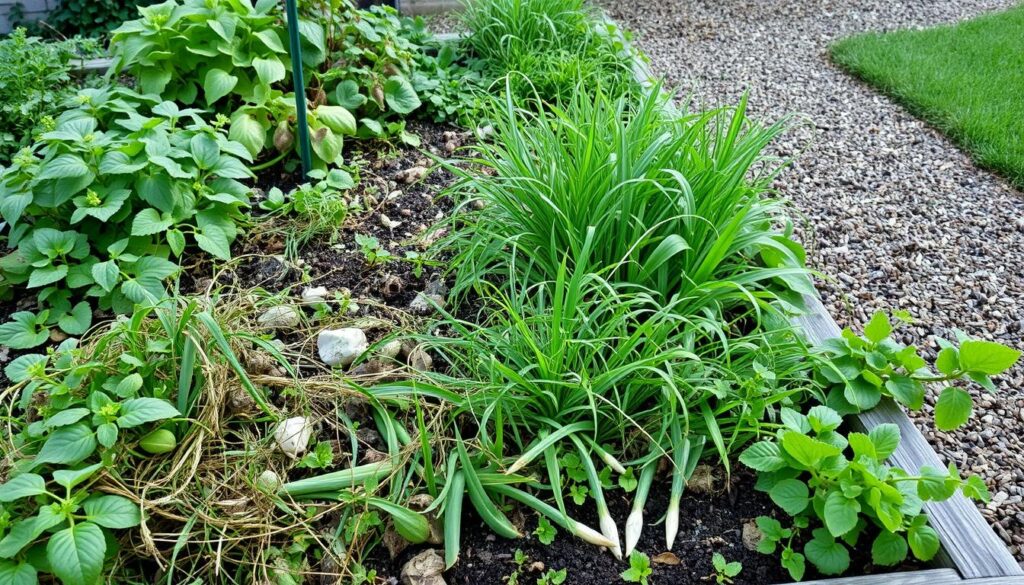
By addressing these common mistakes, you can create a healthier and more productive garden. Focus on proper spacing, soil care, and drainage to ensure your plants thrive.
Advanced Techniques for Raised Bed Gardening
Taking your gardening skills to the next level requires mastering advanced techniques. These methods not only boost yields but also improve the health of your garden. From companion planting to succession strategies, here’s how to maximize your results.
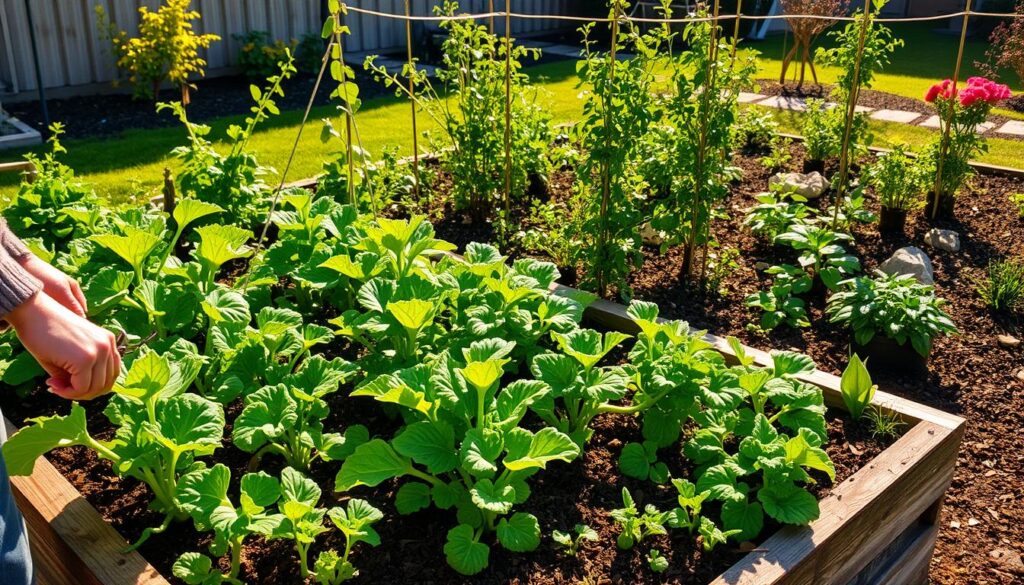
Companion Planting
Companion planting is a smart way to grow plants that benefit each other. For example, the three-sister method—combining corn, beans, and squash—boosts yields by 25%. Corn provides support for beans, beans fix nitrogen in the soil, and squash shades the ground, reducing weeds.
Other effective pairings include tomatoes with basil, which deters pests, and carrots with onions, which confuse harmful insects. Here’s a quick guide to get started:
- Plant marigolds near tomatoes to repel nematodes.
- Grow lettuce alongside radishes for efficient space use.
- Pair cucumbers with nasturtiums to deter aphids.
Succession Planting
Succession planting ensures your garden stays productive all year. By planting new crops as soon as others are harvested, you make the most of your time and space. For example, after harvesting early spring lettuce, plant heat-tolerant beans in the same spot.
Here’s a simple year-round planting calendar:
| Season | Crops |
|---|---|
| Spring | Lettuce, peas, radishes |
| Summer | Tomatoes, peppers, beans |
| Fall | Kale, carrots, spinach |
Using Cover Crops
Cover crops are a game-changer for maintaining healthy soil. Clover, for instance, fixes 150 pounds of nitrogen per acre, enriching the ground naturally. These crops also prevent erosion and suppress weeds during the off-season.
Here are some popular cover crops and their benefits:
- Clover: Fixes nitrogen and attracts pollinators.
- Rye: Prevents erosion and adds organic matter.
- Buckwheat: Suppresses weeds and improves soil structure.
“Cover crops are the unsung heroes of sustainable gardening. They protect and nourish the soil, ensuring long-term productivity.”
By incorporating these advanced techniques, you can transform your garden into a thriving, productive space. Focus on companion planting, succession strategies, and cover crops to achieve the best results.
Conclusion: Transform Your Yard with Raised Bed Landscaping
Creating a beautiful outdoor space is easier than you think with the right approach. Raised bed landscaping offers a simple yet effective way to enhance your garden, improve accessibility, and boost yields. Whether you’re a beginner or an experienced gardener, this method can transform your home’s outdoor area.
Start small with a 4×4 garden to get the hang of it. This manageable size allows you to experiment with different plants and techniques. Plus, it’s a great way to connect with your community by sharing tips and produce with neighbors.
For long-term success, consider a 5-year maintenance plan. Regularly check soil health, rotate crops, and update your setup as needed. Ready to get started? Download our free soil guide to ensure your garden thrives from day one.

